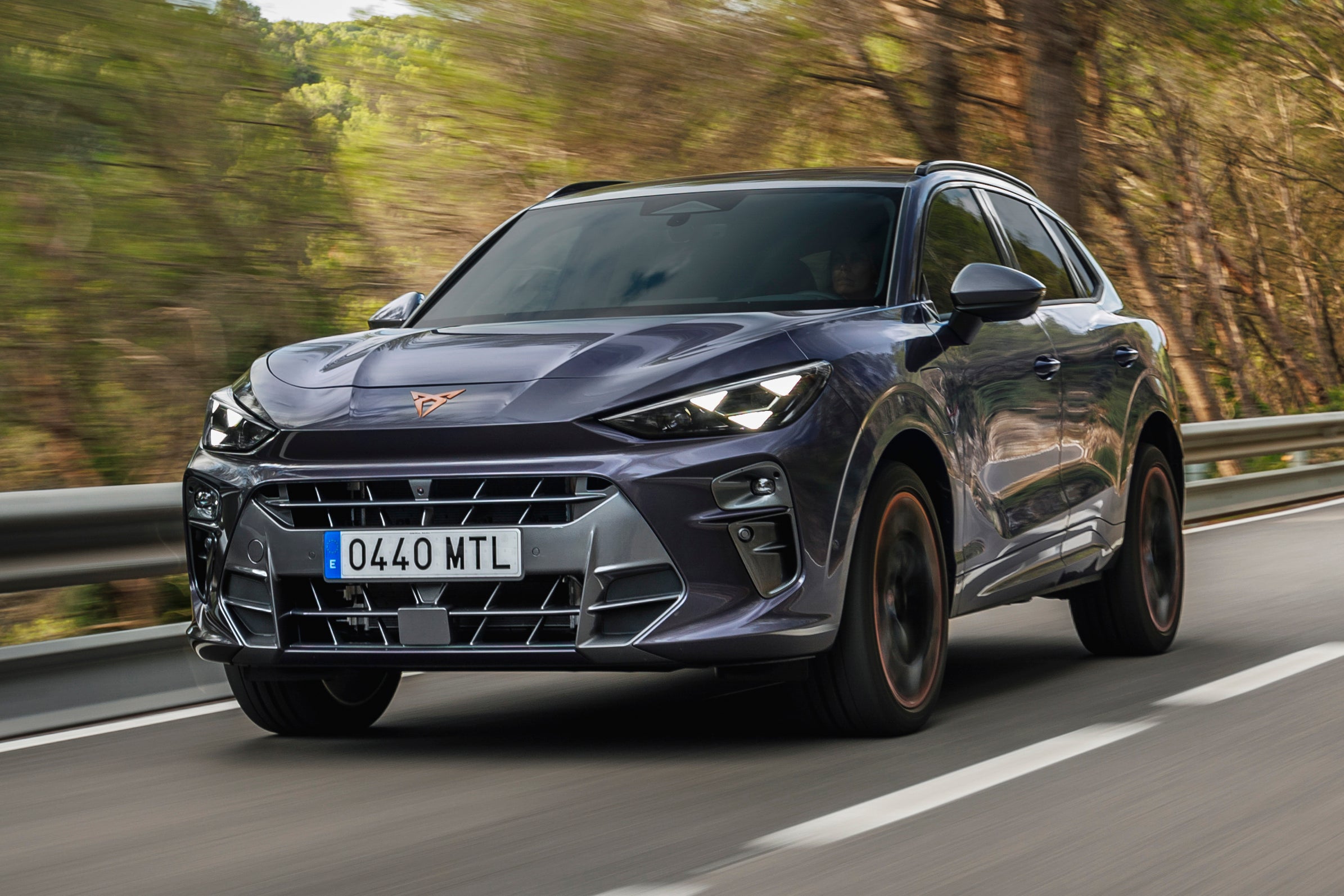Cupra Terramar Review 2025: Price, specs & boot space
Written by Ivan Aistrop
Quick overview
Pros
- Looks great
- Enjoyable to drive
- All versions well equipped
Cons
- Infotainment has usability issues
- PHEV not as dynamically polished as the petrol
- We suspect ride will feel firm on UK roads
Overall verdict on the Cupra Terramar
"If you’re wondering where the moniker ‘Terramar’ comes from, it’s named after an old banked race circuit in the Sitges area of Spain, near Barcelona, where Cupra first announced its intention to break away from SEAT and become its own sporty brand. Naming a midsize family SUV after a race circuit is a bit strange, right? Well, Cupra would have you believe that the Terramar is no ordinary SUV. We’ll discover whether that’s true in this Cupra Terramar review."
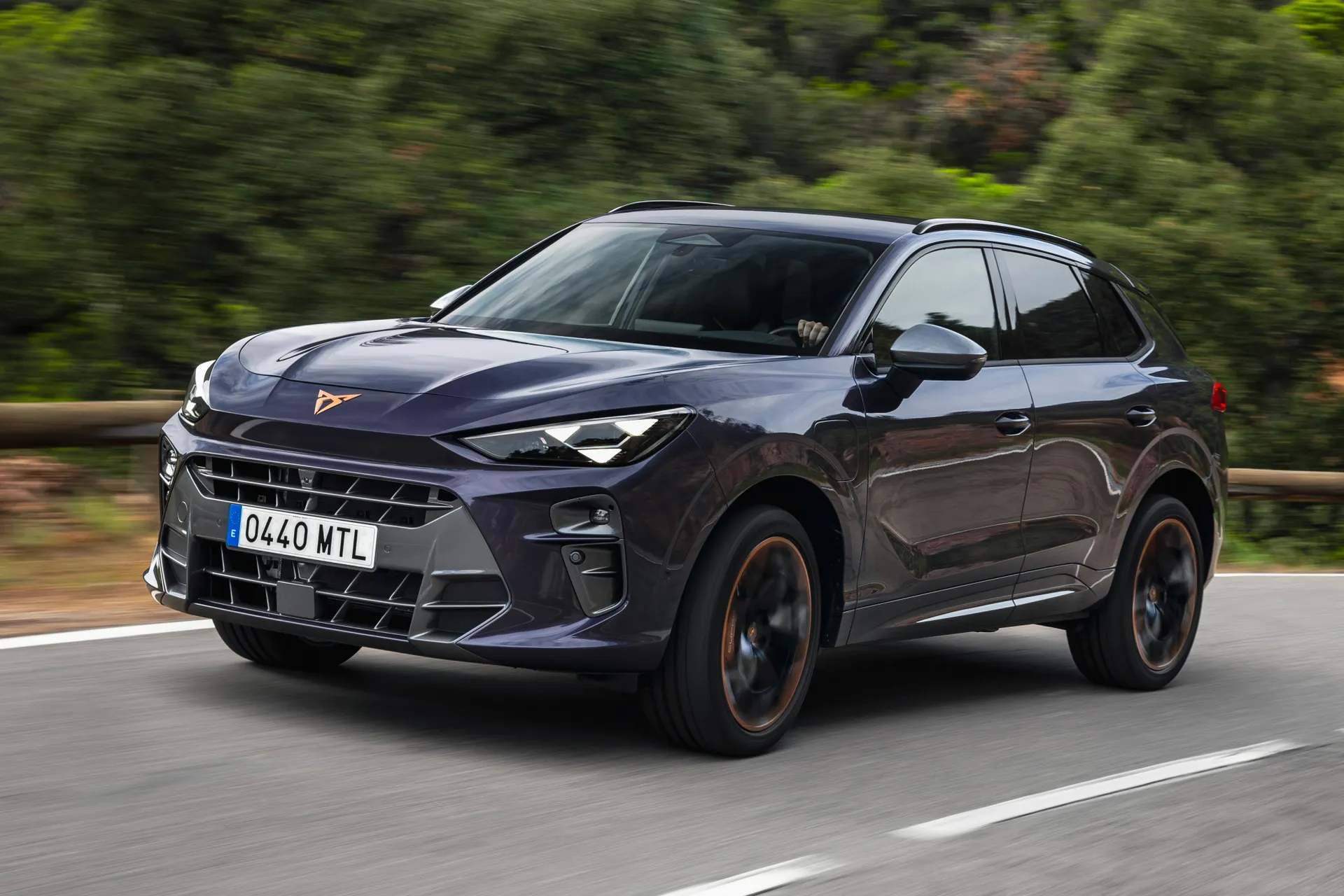
SEAT was traditionally seen as the sportiest member of the various Volkswagen brands, and when Cupra came along in 2018, it aimed to be sportier still. The Terramar, then, is aimed at the very sportiest end of the midsize family SUV spectrum.
Unsurprisingly, it shares its MQB Evo platform with the latest Volkswagen Tiguan, which is a very similar size, but aims to provide a much racier experience. It certainly looks more aggressive than its straight-suited sibling, with curvaceous lines, expressive detailing and a generally meaner, more menacing character. The interior is moodier, too with dark colour schemes interspersed with flashes of metallic trim in the brand’s trademark copper colour.
Inside, you get a very similar amount of space for passengers and luggage to that which you get in the Tiguan, meaning that it's practical enough to use as a family car. Standard equipment is generous on even the base-level trims, and the mandatory large-screened touch-sensitive infotainment system is present and correct. So is all the expected driver assistance tech. The prices of the higher-end versions look a bit steeper, but these come even more generously equipped. You also have the reassurance of an impressive five-year, 90,000-mile warranty.
Where the Cupra Terramar really needs to mark itself out, though, is on the road. And it’s pretty successful in that regard, based on what we’ve experienced. We’ve so far driven the most powerful petrol and plug-in hybrid versions, which are fitted as standard with an adaptive suspension (more modest versions have a passive suspension that’s lowered compared to the Tiguan to make it feel racier). This certainly gives you a feeling of connection with the road, while the steering is feelsome and beautifully weighted. The PHEV doesn’t feel as agile or as satisfying as the petrol we drove, but both are enjoyable. We must caveat all that by saying that our test drive took place on immaculate Spanish roads, so how the suspension deals with the UK’s lumpier surfaces remains a bit of a mystery, but we’ll let you know as soon as we find out.
All in all, the Cupra Terramar is a very convincing and compelling entrant into the midsize SUV market, and if you want you family carry-all to have something of a sporting edge, then we’d recommend you check it out, although orders won’t open until the end of November 2024, and the first cars won’t arrive in the UK until around March 2025.
Looking for a used car for sale? We've got 100s of Cupra Approved Used Cars for Sale, for you to choose from, including a wide range of Cupra Terramar cars for sale.
Is the Cupra Terramar right for you?
Absolutely it is if you're looking for a family SUV like the Volkswagen Tiguan or Nissan Qashqai, but you want one with a bit more aggression in how it looks, and more edge to how it drives. It’s practical enough to serve as a family car, and quality is also pretty good. The high-end versions do look a bit expensive, but the more modest ones look like good value, especially considering the generous standard equipment you get.
What’s the best Cupra Terramar model/engine to choose?
The Terramar is supposed to be a sporty offering in the midsize SUV market, and the version that plays that role best is the 265PS 2.0-litre petrol version. It has the strongest pace of the range despite being down on power compared with the range-topping 272PS plug-in hybrid version, and its lower weight means it feels much more fluid and unflustered on the road, plus it’s comfier, too. Then again, it’s pretty thirsty, so if you’d prefer strong fuel economy and low company car tax bills with a little bit of style, then the PHEV is the version to have.
What other cars are similar to the Cupra Terramar?
There’s one car that’s extremely similar to the Cupra Terramar, and that’s the Volkswagen Tiguan, because both are built on the same MQB Evo platform. The same platform will also underpin the forthcoming new version of the Audi Q3, and the Terramar is even built at Audi’s factory in Gyor, Hungary.
Other than that, the Terramar plays rivals to pretty much every midsize SUV model on the market, of which there are ridiculous numbers due to the popularity of this type of car. The Nissan Qashqai, Kia Sportage, Hyundai Tucscon, Honda CR-V, Peugeot 3008, Citroen C5 Aircross, Vauxhall Grandland: all of them will be fighting for your cash.
Comfort and design: Cupra Terramar interior
"The interior design in the Terramar looks like it’s meant to reflect the aggressive, menacing attitude that Cupra is trying to achieve with the car."
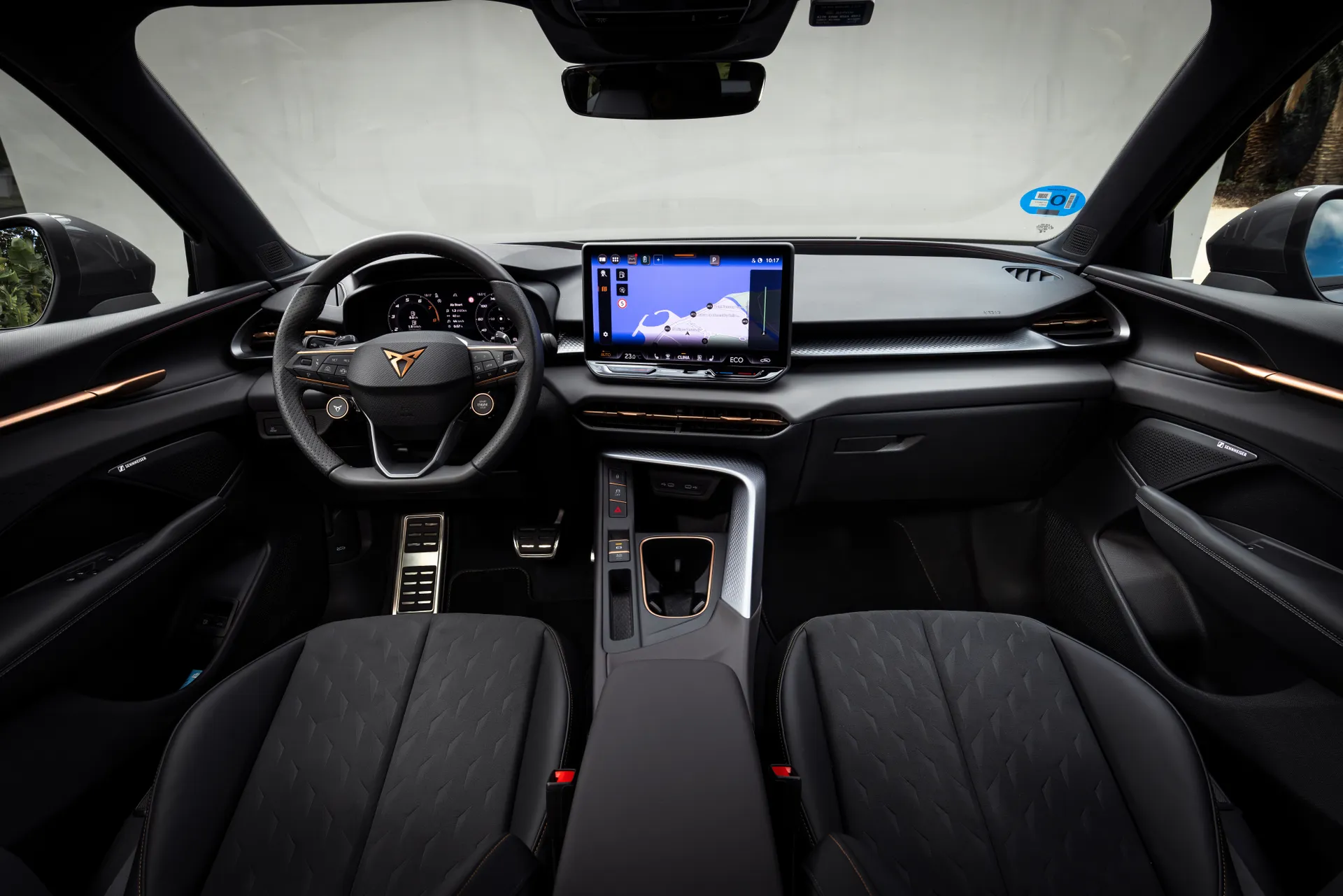
As such, the colour schemes - three are available - are dark and moody, with a few flashes of bright metallic trim to provide a small amount of light relief, while you’ll also see plenty of bronze accents dotted about the place, Cupra’s trademark colour.
The dashboard layout takes the minimalist approach that is so fashionable these days, so there’s very little switchgear on display, so most functions are dealt with through the central touchscreen: more on that in a minute.
Cupra says that bucket seats are provided on all versions, but that being the case, they’re a little short on side support compared with other bucket seats we’ve encountered. They’re still comfy and supportive, though, and there’s plenty of adjustment to help you get comfy. On high-spec models, this adjustment is electric.
Quality and finish
Sit up front in the Terramar, and you’ll probably be quite impressed. Most of the materials you interact with in the dashboard and door areas are of a high quality, with plenty of squidgy cushioned surfaces to be found, while the various metallic trims also help communicate a feeling of sturdiness.
Look further back in the cabin, though, and you’ll notice the quality deteriorates slightly. When you’re sat in the back, the plastics that surround you are harder and scratchier than they are further forward, so you do feel a little bit like a second-class citizen. It doesn’t feel low-rent by any means, but rivals are a bit more uniform in the quality of the materials they use.
Infotainment: Touchscreen, USB, nav and stereo in the Cupra Terramar
All versions of the Cupra Terramar get the same infotainment system, with precisely the same level of functionality. That functionality includes all the usual stuff, such as DAB, Bluetooth, Apple CarPlay and Android Auto. You also get built-in sat-nav, and four USB ports are on hand to keep everyone’s devices charged, heaven forbid the kids should be without them for five minutes.
There’s a reasonably clear 10.25-inch digital instrument screen behind the steering wheel to deliver all your important driving information, but the main event is the 12.9-inch touchscreen plonked on the centre of the dashboard. It looks good, with sharp, colourful graphics and crisp screen transitions, and the screen sensitivity is better than on a lot of such systems, so you have a fighting chance of your instruction being recognised first time.
Finding where you should be making that input might be more of a challenge, though. The home screen looks cluttered, and has too many icons to signify different menus or clusters of functions, and too many of these icons are ambiguously designed so that it’s not immediately obvious what manner of functionality lies behind. And once you’re into the menu structure, the way they’re arranged can be rather illogical and confusing, so you’ll probably find yourself hunting around for minor functions, distracting you from the road ahead as you do so. We’ve encountered worse systems for this, but we’ve also encountered better.
Space and practicality: Cupra Terramar boot space
The Cupra Terramar’s chunky aggressive styling might well make it look a little bigger than it really is: it’s actually a reasonably compact car by SUV standards. In terms of dimensions, it measures 4,519mm long, 1,584mm tall and 1,863mm wide (without door mirrors), while the wheelbase stands at 2,681mm.
As a result, it might not be quite as roomy as you’re expecting. The front seats are fine for space - as they always are - while in the rear seats, headroom and legroom are generous enough for a pair of six-foot adults to get comfortable, but it’s nothing exceptional; rival models give folks more room to stretch out. Things get tighter still when you move the sliding rear seats to the forwardmost position on their 150mm travel, where rear legroom becomes very tight indeed, and your kneecaps will be pressed against the seats in front, which are hard-backed, so it’s not very comfortable. Squeezing a third person into the back will be possible for short trips, but you wouldn’t want to be the one sitting there for long periods because the seat is narrower than those either side (although it’s not too bad in the scheme of things), and there’s a hump in the floor that your feet will have to straddle.
In the petrol model, boot space stands at between 540 litres and 642 litres, depending on where the sliding rear seat is positioned, but that’s provided you take out the removable boot floor. With it in place, the boot becomes pretty much the same size as the plug-in hybrid’s, which stands at between 400 litres and 490 litres. It also levels off both the boot lip and the step up to the rear seatbacks when they're folded down, and because the backrests lie flat, your extended load area has no inconvenient steps or slopes.
Handling and ride quality: What is the Cupra Terramar like to drive?
"So far, we’ve driven two versions of the Terramar, the most powerful 265PS petrol version, and the most powerful 272PS plug-in hybrid version. Both of these are fitted as standard with adaptive dampers that vary their level of stiffness in various stages according to which of the driving modes you select. Regardless of this similarity, though, the two versions are rather different in how they behave on the road."
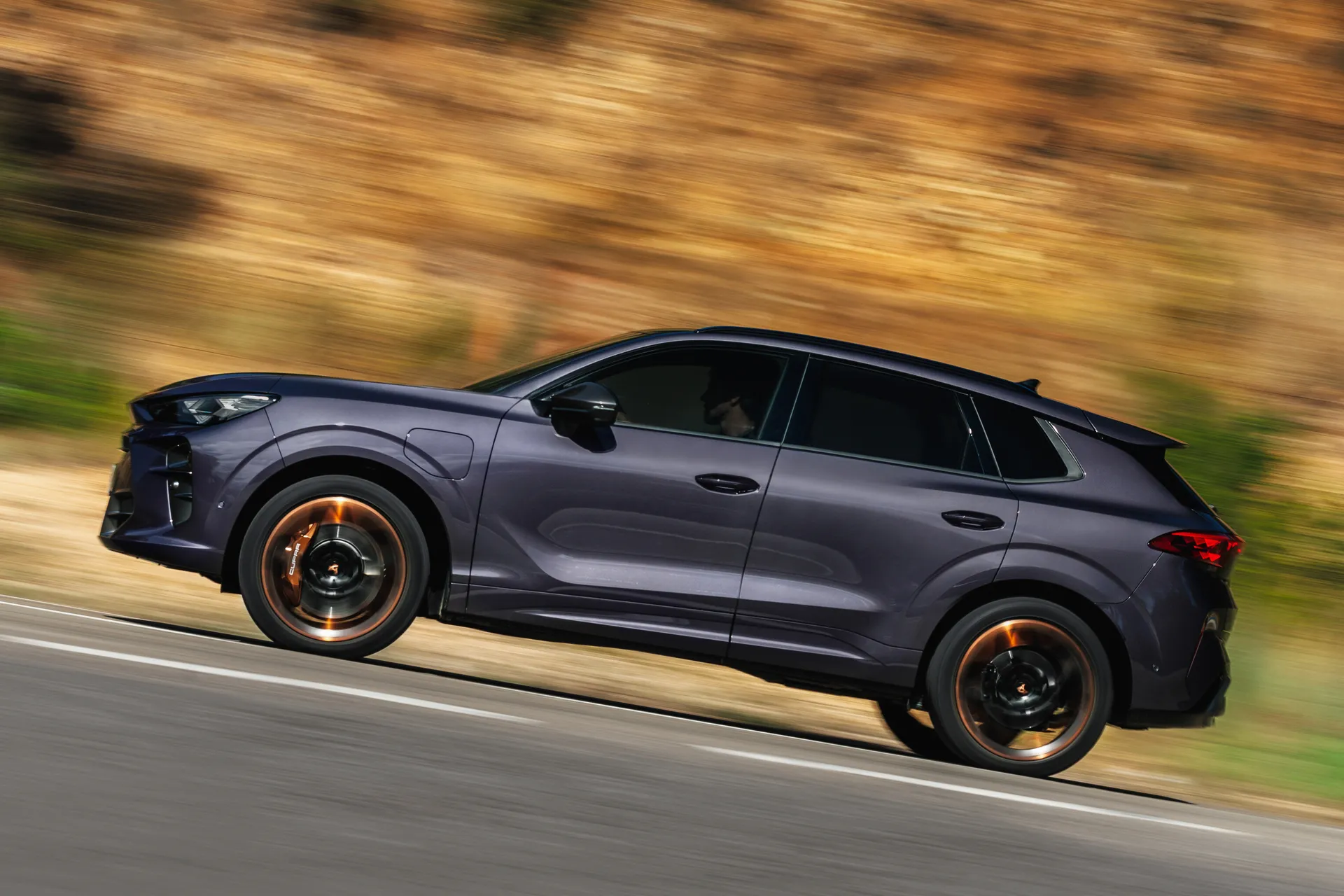
Let’s discuss the former first. You can certainly feel the difference in suspension stiffness as you scroll through the modes: the comfort-orientated ones certainly make things a little more forgiving, while the sportier ones introduce more of an edge and tie down body movements more effectively for sharper responses. Whatever your mode, however, the car changes direction with impressive crispness, with lots of grip and traction from the standard four-wheel drive, good resistance to body roll, and steering that feels responsive, connected, and beautifully weighted.
In terms of ride comfort, we found things to be impressively smooth and comfortable on the immaculate Spanish roads of our test routes, but on the few lumps and bumps we did encounter, we felt an inherent firmness that led us to believe that the Terramar might struggle a bit more to mop up the effects of your average battered British street. We can’t be sure that’s the case until we’ve tried it in such circumstances, though, so we’ll keep you posted once we do.
The same applies to the hybrid version, both on the underlying firmness issue, and the fact that we’ll have to try the car in the UK before we deliver a definitive verdict. Again, the differences in the suspension can be felt between the modes, even though these aren’t quite as pronounced as they are in the petrol. However, the ride in the PHEV generally feels a little firmer, with slightly more fidget and tremble than you feel in the petrol. It’s not uncomfortable (or at least it wasn’t on smooth Spanish roads), but it is a bit less comfortable. We suspect this might be due to the extra weight sitting on the springs, the PHEV weighing 154kg more than the petrol.
That extra weight can be felt in the handling, too. It feels a bit heavier in pretty much all driving situations: you feel more weight transfer as you change direction, the tyres have a slightly harder time gripping the Tarmac, and a lot more pressure needs to be put on the brake pedal to get the car to pull up. And that’s with both our test cars being fitted with optional Akebono brakes. The hybrid is still an enjoyable car to drive, but it just doesn’t flow from bend to bend quite as cleanly as the petrol.
Lesser versions of the Terramar are fitted as standard with passive (meaning non-adaptive) sports suspension that’s 10mm lower than the settings found on the VW Tiguan. Not only have we not tried that setup on British roads, we haven’t tried it at all, so we can’t say anything about what that might be like.
What engines and gearboxes are available in the Cupra Terramar?
Like we said, we’ve so far only driven the two most powerful versions of the Cupra Terramar, the 265PS 2.0-litre turbocharged petrol version, and the 272PS eHybrid plug-in hybrid, which combined a 1.5-litre four-cylinder petrol engine with an electric motor. Both are connected to their drive wheels by a DSG twin-clutch gearbox - a seven-speed unit in the former and a six-speeder in the latter - and while the PHEV is driven by just its front wheels, the petrol is driven by all four.
The petrol has an official 0-62mph time of 5.9 seconds, while the PHEV sees off the same benchmark in 7.3 seconds. In truth, though, neither feels as quick as the figures suggest. The petrol feels brawny and eager enough to make hasty progress when needed, but it never feels downright fast. The Hybrid’s extra weight makes it feel far more leisurely despite its superior overall power output, although we suspect the level of performance on offer will be fine for the majority of customers.
The other thing that hampers the PHEV is a rather inconsistent power delivery. Sometimes, you’ll bury the throttle and very little will happen in the way of extra forward motion, while other times, you’ll barely move your accelerator foot, and the powertrain will have you surging forwards in a rather uncontrolled-feeling way. So, you never quite know what level of acceleration your car is going to serve up from one moment to the next.
The other powertrain on offer initially is a mild hybrid (badged eTSI) version that uses the same 1.5-litre petrol engine found in the PHEV to deliver 150PS. Later on, two more engines will join the range, a 2.0-litre petrol turbo with 204PS, and a lower-powered version of the plug-in hybrid, also with 204PS.
Refinement and noise levels
When used in a normal moderate fashion, the 2.0-litre petrol engine is smooth and subdued, staying in the background at all times and remaining nice and unstressed on the motorway. Work it harder, and it still stays impressively muted, which might be a good thing or a bad thing depending on how devil-may-care you’re feeling.
If the mood takes you, that can be remedied by selecting either the Performance or Cupra modes, which results in a synthetic burbly V8-style engine noise being piped into the cabin. It’s not entirely convincing (not by a long shot), and so will divide opinion: some will consider it a cheerful gimmick, while others will think it’s rather contrived.
The PHEV version is, as you’d imagine, incredibly quiet when you’re trundling around on electric-only power, which it can do up to 87mph if you keep your throttle inputs gentle. A gentle throttle will also keep the petrol engine quiet when it finally kicks in, but when it’s made to work harder, it can sound rather loud and thrashy. This can happen rather frequently, too, because the automatic transmission is rather clumsy in the way it swaps cogs, and the engine revs can often be sent soaring by the gearbox without you being particularly demanding on pace.
Wind- and road noise are nothing to write home about, so high-speed refinement isn’t class leading, but it’s nowhere near troublesome, either.
Safety equipment: How safe is the Cupra Terramar?
Seven airbags are fitted as standard to the Terramar to help keep you from harm should a crash happen. There’s also a variety of semi-autonomous driver aids on hand to help prevent you from having one in the first place, including automatic emergency braking, lane assist, dynamic road sign display and adaptive cruise control. V2 and VZ2 trims bring a few more measures, including an advanced driver alert system, advanced lane assist, traffic jam assist, blind spot monitoring, and rear cross traffic assist.
The Cupra Terramar was tested by safety organisation Euro NCAP in 2025 and scored the maximum five stars, with high marks for adult occupant safety (89%), child occupant safety (87%) and for protection of vulnerable road users (82%).
MPG and fuel costs: What does a Cupra Terramar cost to run?
"With a variety of different powertrains on offer, it’s no surprise that there’s quite a bit of disparity between the official fuel economy figures for the various versions."
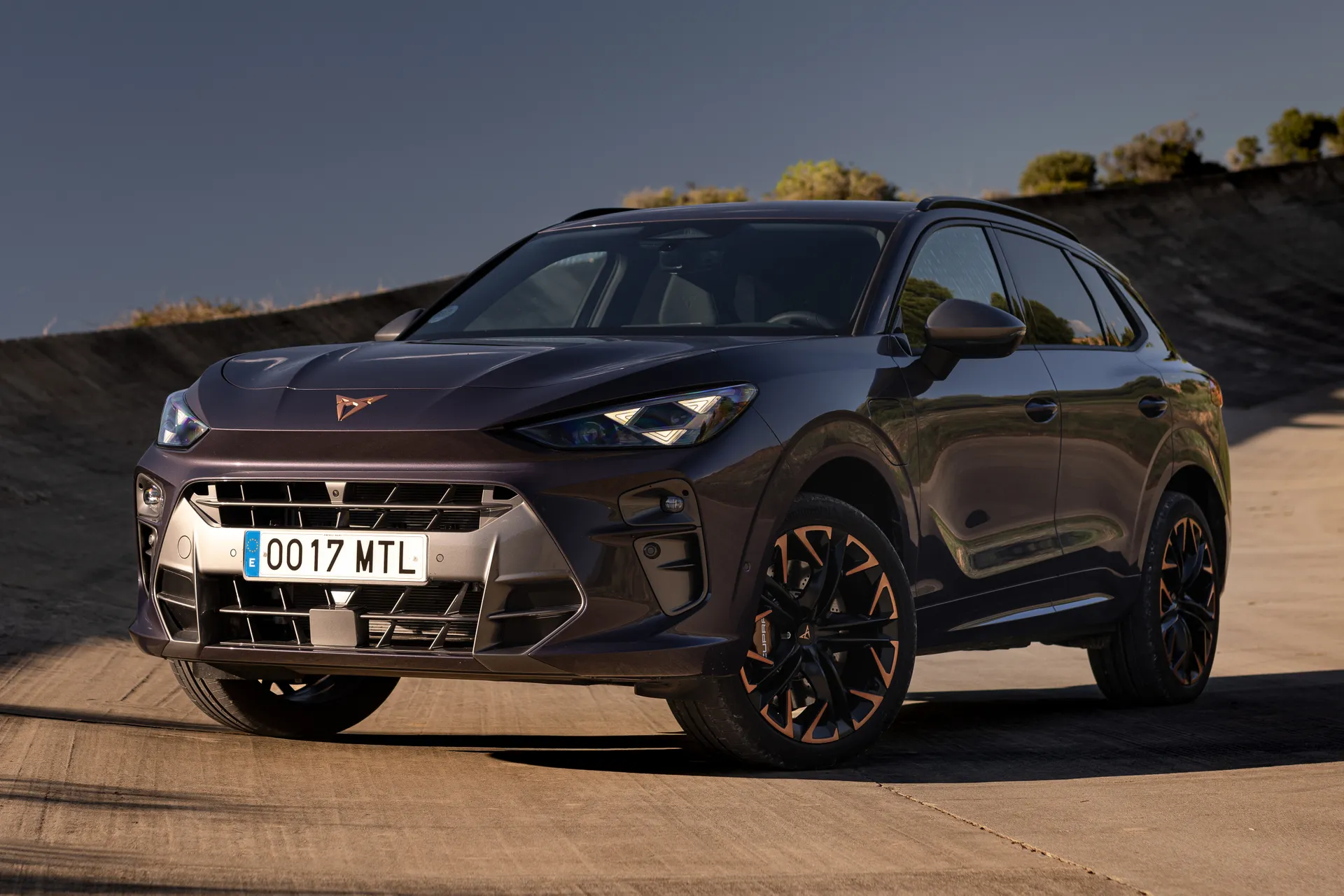
Go for the 265PS 2.0-litre petrol version, and the official WLTP fuel consumption figures stand at between 32.1 mpg and 33.6mpg on the combined cycle. Pretty thirsty, then.
Go for the 150PS 1.5-litre mild hybrid, and things get a bit better, with official figures sitting between 42.8mpg and 46.3mpg.
Official figures for the 272PS PHEV version stand at a frankly ludicrous 565mpg to 704mpg. Don’t be taken in, because the official tests are unrealistically flattering to plug-in hybrids, and you’re unlikely to get anywhere near that in real life. The simple fact is that if you keep your car charged up and only ever use the all-electric range of 70 miles to get around, then you’ll never use a drop of fuel. Regularly rely on the petrol motor, though, and you’ll use loads. As soon as the petrol engine kicks into life, it not only has to drag the weight of the car’s body around, but also the weight of the extra batteries and motors, and that will make it very thirsty indeed.
Cupra Terramar reliability and warranty
Cupra is a fairly new brand, and so doesn’t yet feature in our go-to source of reliability and customer satisfaction data, the HonestJohn.co.uk Satisfaction Index, compiled by our sister website.
As we know, the brand shares a lot with Volkswagen and SEAT in terms of platforms and parts, these brands sitting in 21st and 22nd places, respectively, out of the 29 carmakers considered in the study’s overall manufacturer standings. That might not fill you with confidence, but VW and SEAT models with the same mechanicals used in the Terramar will be too new to have contributed to that performance.
Cupra’s warranty package might fill you with a bit more confidence, though, with five-year, 90,000-mile cover.
Cupra Terramar insurance groups and costs
It’s still a few months before the Cupra Terramar officially goes on sale in the UK, with the order books not opening until later November of 2024, while first customer deliveries aren’t expected until March 2025 at the earliest. That means many details are yet to be finalised, and the car’s insurance groups are among them. Once we know, we’ll update this review right away.
VED car tax: What is the annual road tax on a Cupra Terramar?
The purely petrol versions of the Cupra Terramar will be liable for the same flat rate of VED road tax as all other petrol and diesel cars, which currently stands at £190 per year. The mild hybrid and plug-in hybrid versions qualify for a discount on that, but it’s only a tenner, which is too measly to make a great difference to your buying decision.
The greater advantage will come for company car drivers who choose the PHEV. It’s super-impressive all-electric range of more than 70 miles qualifies it for the lowest possible rate of Benefit in Kind company car tax, which stands to save you a packet in monthly tax bills compared with a regular petrol or diesel car.
Cupra Terramar price
"List prices for a brand new Terramar begin at just over £37,000, which is for the 150PS mild hybrid in V1 trim. Where the regular trims are concerned, they rise to around £50,000 for the VZ2 with the 272PS PHEV powertrain, but the limited-run First Edition and Americas Cup Edition models cost a wee bit more on top."
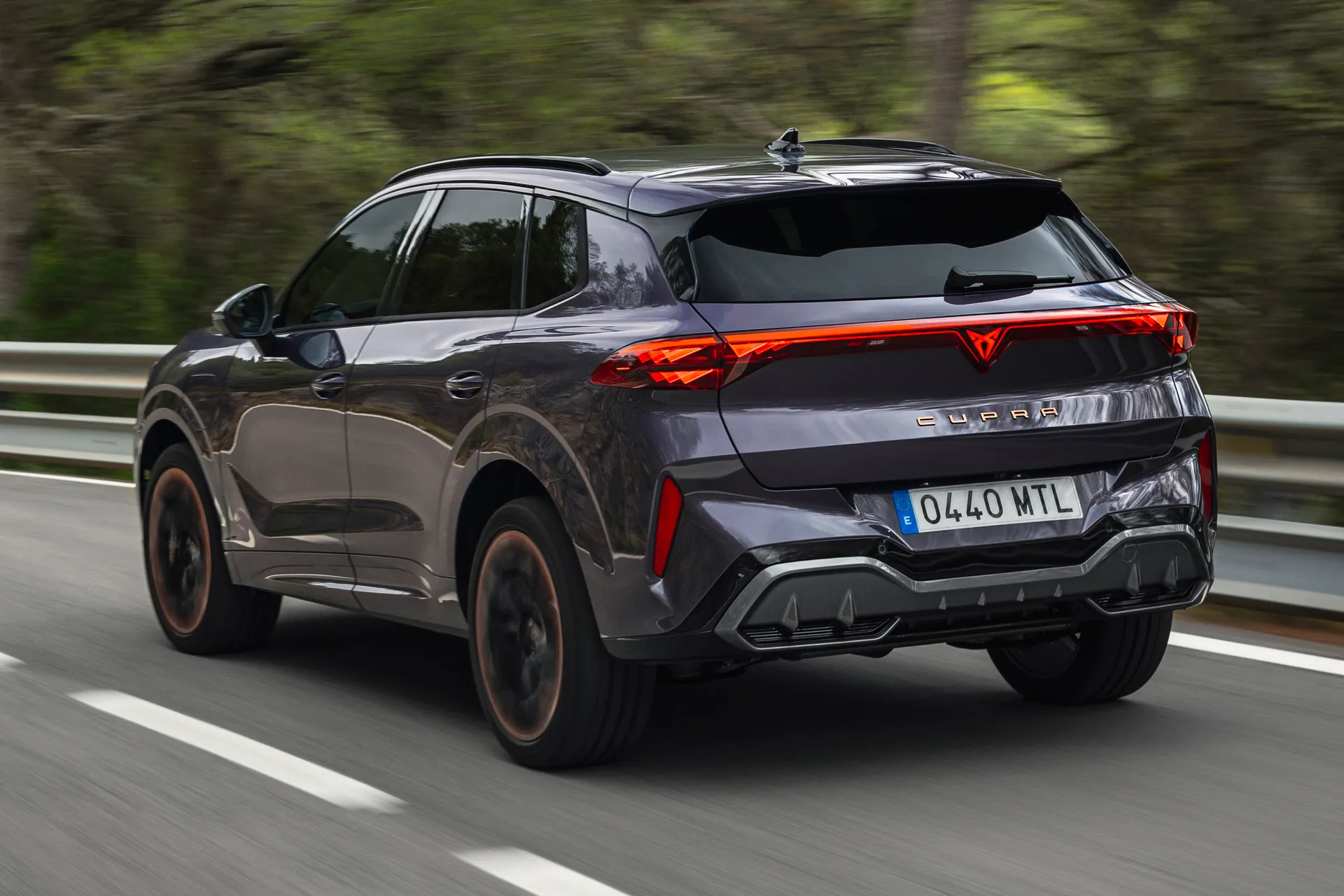
As regards finding a used example, it’s a wee bit early for that. The Terramar doesn’t even open for ordering until the back end of November 2024, and the first customer cars won’t arrive until March 2025 at the earliest, so it’ll be a while yet before you’ll find pre-registered examples and ex-demonstrator cars knocking about on the used car market.
Trim levels and standard equipment
A variety of trim levels are offered with the Cupra Terramar, but their availability depends on which powertrain you choose. The more modest version come in V1 and V2 versions, while the most powerful petrol and plug-in hybrid versions (the ones we’ve driven, in other words) are offered in VZ1 and VZ2 trims.
In fairness, the base-level V1 car still comes pretty well stocked, with alloy wheels, LED exterior lighting, automatic lights and wipers, heated and electrically foldable door mirrors, front-and rear parking sensors, a reversing camera, keyless entry and start, ambient interior lighting, three-zone climate control, a heated leather steering wheel, bucket seats, a powered tailgate, and adaptive cruise control. That’s in addition to all the infotainment and safety gear we talked about earlier.
The step up from V1 to V2 earns you electrically adjustable and heated front seats trimmed in alcantara-effect upholstery, plus 360-degree cameras and a head-up display.
The VZ trims do things slightly differently. VZ1 cars get the heated and powered front seats trimmed in faux-alcantara, self-adjusting high-definition HD Matrix headlights, and dynamic chassis control adaptive suspension. VZ2, meanwhile, adds leather upholstery, 360-degree cameras,and a head-up display.
If that weren't confusing enough, early versions of the Terramar are also available in a couple of special-edition trims. The VZ First Edition trim takes the VZ2’s roster and adds copper-coloured wheels, a panoramic roof, a Sennheiser sound system with surround sound, plus metallic paint. The America's Cup Edition, meanwhile, gets matte grey paint and special leather seats.
Ask the heycar experts: common questions
Is the Cupra Terramar a good car?
Is the Cupra Terramar an SUV?
Is the Cupra Terramar electric?
Get our latest advice, news and offers
Keep me updated by email with the latest advice, news and offers from heycar.
By submitting you agree to our privacy policy
